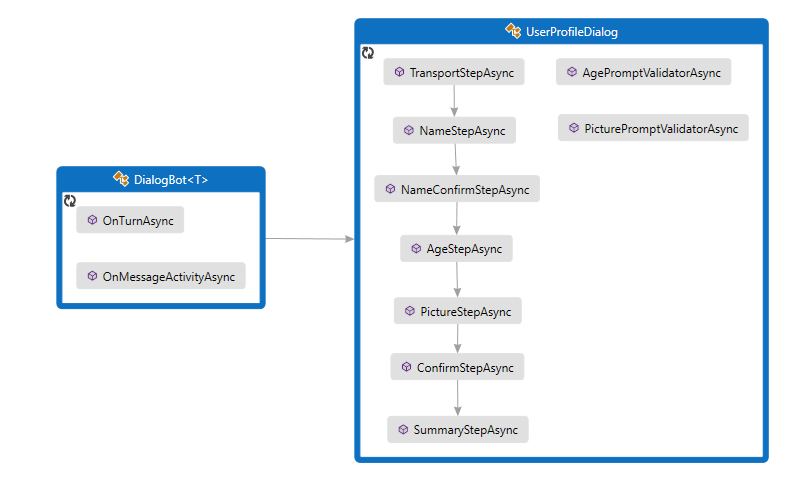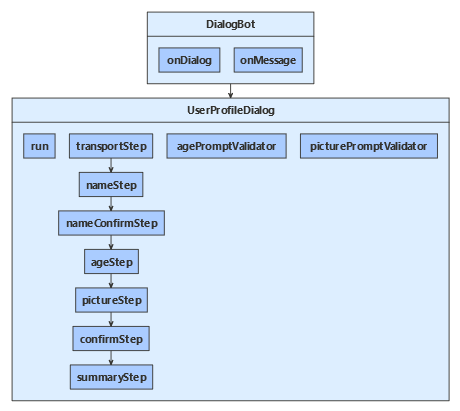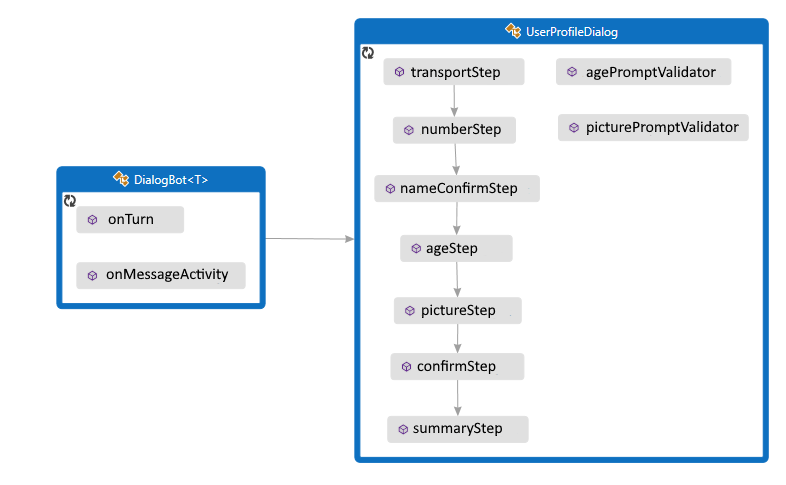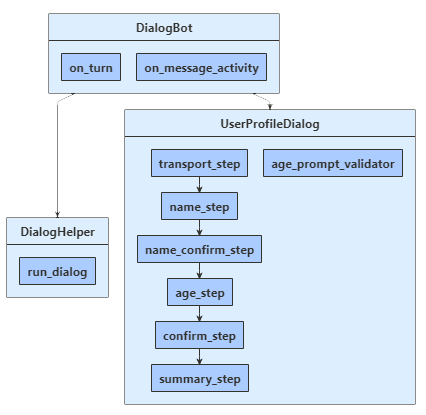您可以使用對話方塊程式庫來管理線性和更複雜的交談流程。 線上性互動中,Bot 會透過固定的步驟循序執行,而交談會完成。 當 Bot 需要從使用者收集資訊時,對話方塊會很有用。
若要使用對話方塊,請安裝 Microsoft.Bot.Builder.Dialogs NuGet 套件。
Bot 會透過 UserProfileDialog 與使用者互動。 建立 Bot 的 DialogBot 類別時,會 UserProfileDialog 設定為其主要對話方塊。 接著,Bot 會使用 Run 協助程式方法來存取對話方塊。

Dialogs\UserProfileDialog.cs
首先,建立 UserProfileDialog 衍生自 類別的 ComponentDialog ,並具有七個步驟。
在建構函式中 UserProfileDialog ,建立瀑布步驟、提示和瀑布對話,並將其新增至對話集。 提示必須位於所使用的相同對話方塊集中。
public UserProfileDialog(UserState userState)
: base(nameof(UserProfileDialog))
{
_userProfileAccessor = userState.CreateProperty<UserProfile>("UserProfile");
// This array defines how the Waterfall will execute.
var waterfallSteps = new WaterfallStep[]
{
TransportStepAsync,
NameStepAsync,
NameConfirmStepAsync,
AgeStepAsync,
PictureStepAsync,
ConfirmStepAsync,
SummaryStepAsync,
};
// Add named dialogs to the DialogSet. These names are saved in the dialog state.
AddDialog(new WaterfallDialog(nameof(WaterfallDialog), waterfallSteps));
AddDialog(new TextPrompt(nameof(TextPrompt)));
AddDialog(new NumberPrompt<int>(nameof(NumberPrompt<int>), AgePromptValidatorAsync));
AddDialog(new ChoicePrompt(nameof(ChoicePrompt)));
AddDialog(new ConfirmPrompt(nameof(ConfirmPrompt)));
AddDialog(new AttachmentPrompt(nameof(AttachmentPrompt), PicturePromptValidatorAsync));
// The initial child Dialog to run.
InitialDialogId = nameof(WaterfallDialog);
}
接下來,新增對話方塊用來提示輸入的步驟。 若要使用提示,請從對話方塊中的步驟呼叫它,並使用 stepContext.Result 擷取下列步驟中的提示結果。 在幕後,提示是雙步驟對話方塊。 首先,提示會要求輸入。 然後,它會傳回有效的值,或從開頭以重新編目開始,直到它收到有效的輸入為止。
您應該一律從瀑布式步驟傳回非 Null DialogTurnResult 。 如果您未這麼做,您的對話方塊可能無法如設計般運作。 如下所示是瀑布式對話方塊中 的 NameStepAsync 實作。
private static async Task<DialogTurnResult> NameStepAsync(WaterfallStepContext stepContext, CancellationToken cancellationToken)
{
stepContext.Values["transport"] = ((FoundChoice)stepContext.Result).Value;
return await stepContext.PromptAsync(nameof(TextPrompt), new PromptOptions { Prompt = MessageFactory.Text("Please enter your name.") }, cancellationToken);
}
在 中 AgeStepAsync ,指定使用者輸入無法驗證時的重試提示,可能是因為提示的格式無法剖析,否則輸入會失敗驗證準則。 在此情況下,如果未提供重試提示,提示會使用初始提示文字來重新提示使用者輸入。
private async Task<DialogTurnResult> AgeStepAsync(WaterfallStepContext stepContext, CancellationToken cancellationToken)
{
if ((bool)stepContext.Result)
{
// User said "yes" so we will be prompting for the age.
// WaterfallStep always finishes with the end of the Waterfall or with another dialog; here it is a Prompt Dialog.
var promptOptions = new PromptOptions
{
Prompt = MessageFactory.Text("Please enter your age."),
RetryPrompt = MessageFactory.Text("The value entered must be greater than 0 and less than 150."),
};
return await stepContext.PromptAsync(nameof(NumberPrompt<int>), promptOptions, cancellationToken);
}
else
{
// User said "no" so we will skip the next step. Give -1 as the age.
return await stepContext.NextAsync(-1, cancellationToken);
}
}
UserProfile.cs
使用者的運輸、名稱和年齡模式會儲存在 類別的實例中 UserProfile 。
public class UserProfile
{
public string Transport { get; set; }
public string Name { get; set; }
public int Age { get; set; }
public Attachment Picture { get; set; }
}
Dialogs\UserProfileDialog.cs
在最後一個步驟中,檢查 stepContext.Result 上一個瀑布步驟中呼叫的對話方塊所傳回的 。 如果傳回值為 true,使用者設定檔存取子會取得並更新使用者設定檔。 若要取得使用者設定檔,請呼叫 GetAsync ,然後設定 、 userProfile.NameuserProfile.Age 和 userProfile.Picture 屬性的值 userProfile.Transport 。 最後,在呼叫 EndDialogAsync 之前,摘要說明使用者的資訊,這會結束對話。 結束對話方塊會將對話方塊從對話堆疊中快顯出來,並將選擇性結果傳回給對話方塊的父代。 父代是啟動剛結束之對話方塊的對話方塊或方法。
private async Task<DialogTurnResult> SummaryStepAsync(WaterfallStepContext stepContext, CancellationToken cancellationToken)
{
if ((bool)stepContext.Result)
{
// Get the current profile object from user state.
var userProfile = await _userProfileAccessor.GetAsync(stepContext.Context, () => new UserProfile(), cancellationToken);
userProfile.Transport = (string)stepContext.Values["transport"];
userProfile.Name = (string)stepContext.Values["name"];
userProfile.Age = (int)stepContext.Values["age"];
userProfile.Picture = (Attachment)stepContext.Values["picture"];
var msg = $"I have your mode of transport as {userProfile.Transport} and your name as {userProfile.Name}";
if (userProfile.Age != -1)
{
msg += $" and your age as {userProfile.Age}";
}
msg += ".";
await stepContext.Context.SendActivityAsync(MessageFactory.Text(msg), cancellationToken);
if (userProfile.Picture != null)
{
try
{
await stepContext.Context.SendActivityAsync(MessageFactory.Attachment(userProfile.Picture, "This is your profile picture."), cancellationToken);
}
catch
{
await stepContext.Context.SendActivityAsync(MessageFactory.Text("A profile picture was saved but could not be displayed here."), cancellationToken);
}
}
}
else
{
await stepContext.Context.SendActivityAsync(MessageFactory.Text("Thanks. Your profile will not be kept."), cancellationToken);
}
// WaterfallStep always finishes with the end of the Waterfall or with another dialog; here it is the end.
return await stepContext.EndDialogAsync(cancellationToken: cancellationToken);
}
若要使用對話方塊,您的專案必須安裝 botbuilder-dialogs npm 套件。
Bot 會透過 UserProfileDialog 與使用者互動。 建立 Bot 的 DialogBot 時,會 UserProfileDialog 設定為其主要對話方塊。 接著,Bot 會使用 run 協助程式方法來存取對話方塊。

dialogs/userProfileDialog.js
首先,建立 UserProfileDialog 衍生自 類別的 ComponentDialog ,並具有七個步驟。
在建構函式中 UserProfileDialog ,建立瀑布步驟、提示和瀑布對話,並將其新增至對話集。 提示必須位於所使用的相同對話方塊集中。
constructor(userState) {
super('userProfileDialog');
this.userProfile = userState.createProperty(USER_PROFILE);
this.addDialog(new TextPrompt(NAME_PROMPT));
this.addDialog(new ChoicePrompt(CHOICE_PROMPT));
this.addDialog(new ConfirmPrompt(CONFIRM_PROMPT));
this.addDialog(new NumberPrompt(NUMBER_PROMPT, this.agePromptValidator));
this.addDialog(new AttachmentPrompt(ATTACHMENT_PROMPT, this.picturePromptValidator));
this.addDialog(new WaterfallDialog(WATERFALL_DIALOG, [
this.transportStep.bind(this),
this.nameStep.bind(this),
this.nameConfirmStep.bind(this),
this.ageStep.bind(this),
this.pictureStep.bind(this),
this.confirmStep.bind(this),
this.summaryStep.bind(this)
]));
this.initialDialogId = WATERFALL_DIALOG;
}
接下來,新增對話方塊用來提示輸入的步驟。 若要使用提示,請從對話方塊中的步驟呼叫它,並從步驟內容擷取下一個步驟中的提示結果,在此情況下,請使用 step.result 。 在幕後,提示是雙步驟對話方塊。 首先,提示會要求輸入。 然後,它會傳回有效的值,或從開頭以重新編目開始,直到它收到有效的輸入為止。
您應該一律從瀑布式步驟傳回非 Null DialogTurnResult 。 如果您未這麼做,您的對話方塊可能無法如設計般運作。 如下所示是瀑布式對話方塊中 的 實作 nameStep 。
async nameStep(step) {
step.values.transport = step.result.value;
return await step.prompt(NAME_PROMPT, 'Please enter your name.');
}
在 中 ageStep ,指定使用者輸入無法驗證時的重試提示,可能是因為提示的格式無法剖析,或輸入失敗,而上述建構函式中指定的驗證準則。 在此情況下,如果未提供重試提示,提示會使用初始提示文字來重新提示使用者輸入。
async ageStep(step) {
if (step.result) {
// User said "yes" so we will be prompting for the age.
// WaterfallStep always finishes with the end of the Waterfall or with another dialog; here it is a Prompt Dialog.
const promptOptions = { prompt: 'Please enter your age.', retryPrompt: 'The value entered must be greater than 0 and less than 150.' };
return await step.prompt(NUMBER_PROMPT, promptOptions);
} else {
// User said "no" so we will skip the next step. Give -1 as the age.
return await step.next(-1);
}
}
userProfile.js
使用者的運輸、名稱和年齡模式會儲存在 類別的實例中 UserProfile 。
class UserProfile {
constructor(transport, name, age, picture) {
this.transport = transport;
this.name = name;
this.age = age;
this.picture = picture;
}
}
dialogs/userProfileDialog.js
在最後一個步驟中,檢查 step.result 上一個瀑布步驟中呼叫的對話方塊所傳回的 。 如果傳回值為 true,使用者設定檔存取子會取得並更新使用者設定檔。 若要取得使用者設定檔,請呼叫 get ,然後設定 、 userProfile.nameuserProfile.age 和 userProfile.picture 屬性的值 userProfile.transport 。 最後,在呼叫 endDialog 之前,摘要說明使用者的資訊,這會結束對話。 結束對話方塊會將對話方塊從對話堆疊中快顯出來,並將選擇性結果傳回給對話方塊的父代。 父代是啟動剛結束之對話方塊的對話方塊或方法。
async summaryStep(step) {
if (step.result) {
// Get the current profile object from user state.
const userProfile = await this.userProfile.get(step.context, new UserProfile());
userProfile.transport = step.values.transport;
userProfile.name = step.values.name;
userProfile.age = step.values.age;
userProfile.picture = step.values.picture;
let msg = `I have your mode of transport as ${ userProfile.transport } and your name as ${ userProfile.name }`;
if (userProfile.age !== -1) {
msg += ` and your age as ${ userProfile.age }`;
}
msg += '.';
await step.context.sendActivity(msg);
if (userProfile.picture) {
try {
await step.context.sendActivity(MessageFactory.attachment(userProfile.picture, 'This is your profile picture.'));
} catch {
await step.context.sendActivity('A profile picture was saved but could not be displayed here.');
}
}
} else {
await step.context.sendActivity('Thanks. Your profile will not be kept.');
}
// WaterfallStep always finishes with the end of the Waterfall or with another dialog; here it is the end.
return await step.endDialog();
}
建立擴充方法以執行瀑布式對話
run在 內 userProfileDialog 定義的協助程式方法可用來建立及存取對話內容。 accessor以下是對話方塊狀態屬性的狀態屬性存取子,而 this 是使用者設定檔元件對話方塊。 由於元件對話會定義內部對話集,因此必須建立外部對話集,訊息處理常式程式碼才能看見,並用來建立對話內容。
對話內容是藉由呼叫 createContext 方法來建立,並用來與 Bot 回合處理常式內的對話集互動。 對話內容包含目前的回合內容、父對話和對話方塊狀態,提供在對話中保留資訊的方法。
對話內容可讓您使用字串識別碼啟動對話,或繼續目前的對話(例如具有多個步驟的瀑布式對話)。 對話內容會傳遞至所有 Bot 的對話和瀑布式步驟。
async run(turnContext, accessor) {
const dialogSet = new DialogSet(accessor);
dialogSet.add(this);
const dialogContext = await dialogSet.createContext(turnContext);
const results = await dialogContext.continueDialog();
if (results.status === DialogTurnStatus.empty) {
await dialogContext.beginDialog(this.id);
}
}
Bot 會透過 UserProfileDialog 與使用者互動。 建立 Bot 的 DialogBot 類別時,會 UserProfileDialog 設定為其主要對話方塊。 接著,Bot 會使用 Run 協助程式方法來存取對話方塊。

UserProfileDialog.java
首先,建立 UserProfileDialog 衍生自 類別的 ComponentDialog ,並具有七個步驟。
在建構函式中 UserProfileDialog ,建立瀑布步驟、提示和瀑布對話,並將其新增至對話集。 提示必須位於所使用的相同對話方塊集中。
public UserProfileDialog(UserState withUserState) {
super("UserProfileDialog");
userProfileAccessor = withUserState.createProperty("UserProfile");
WaterfallStep[] waterfallSteps = {
UserProfileDialog::transportStep,
UserProfileDialog::nameStep,
this::nameConfirmStep,
this::ageStep,
UserProfileDialog::pictureStep,
this::confirmStep,
this::summaryStep
};
// Add named dialogs to the DialogSet. These names are saved in the dialog state.
addDialog(new WaterfallDialog("WaterfallDialog", Arrays.asList(waterfallSteps)));
addDialog(new TextPrompt("TextPrompt"));
addDialog(new NumberPrompt<Integer>("NumberPrompt", UserProfileDialog::agePromptValidator, Integer.class));
addDialog(new ChoicePrompt("ChoicePrompt"));
addDialog(new ConfirmPrompt("ConfirmPrompt"));
addDialog(new AttachmentPrompt("AttachmentPrompt", UserProfileDialog::picturePromptValidator));
// The initial child Dialog to run.
setInitialDialogId("WaterfallDialog");
}
接下來,新增對話方塊用來提示輸入的步驟。 若要使用提示,請從對話方塊中的步驟呼叫它,並使用 stepContext.getResult() 擷取下列步驟中的提示結果。 在幕後,提示是雙步驟對話方塊。 首先,提示會要求輸入。 然後,它會傳回有效的值,或從開頭以重新編目開始,直到它收到有效的輸入為止。
您應該一律從瀑布式步驟傳回非 Null DialogTurnResult 。 如果您未這麼做,您的對話方塊可能無法如設計般運作。 如下所示是瀑布式對話方塊中 的 nameStep 實作。
private static CompletableFuture<DialogTurnResult> nameStep(WaterfallStepContext stepContext) {
stepContext.getValues().put("transport", ((FoundChoice) stepContext.getResult()).getValue());
PromptOptions promptOptions = new PromptOptions();
promptOptions.setPrompt(MessageFactory.text("Please enter your name."));
return stepContext.prompt("TextPrompt", promptOptions);
}
在 中 ageStep ,指定使用者輸入無法驗證時的重試提示,可能是因為提示的格式無法剖析,否則輸入會失敗驗證準則。 在此情況下,如果未提供重試提示,提示會使用初始提示文字來重新提示使用者輸入。
private CompletableFuture<DialogTurnResult> ageStep(WaterfallStepContext stepContext) {
if ((Boolean)stepContext.getResult()) {
// User said "yes" so we will be prompting for the age.
// WaterfallStep always finishes with the end of the Waterfall or with another dialog; here it is a Prompt Dialog.
PromptOptions promptOptions = new PromptOptions();
promptOptions.setPrompt(MessageFactory.text("Please enter your age."));
promptOptions.setRetryPrompt(MessageFactory.text("The value entered must be greater than 0 and less than 150."));
return stepContext.prompt("NumberPrompt", promptOptions);
}
// User said "no" so we will skip the next step. Give -1 as the age.
return stepContext.next(-1);
}
UserProfile.java
使用者的運輸、名稱和年齡模式會儲存在 類別的實例中 UserProfile 。
// Copyright (c) Microsoft Corporation. All rights reserved.
// Licensed under the MIT License.
package com.microsoft.bot.sample.multiturnprompt;
import com.microsoft.bot.schema.Attachment;
/**
* This is our application state.
*/
public class UserProfile {
public String transport;
public String name;
public Integer age;
public Attachment picture;
}
UserProfileDialog.java
在最後一個步驟中,檢查 stepContext.Result 上一個瀑布步驟中呼叫的對話方塊所傳回的 。 如果傳回值為 true,使用者設定檔存取子會取得並更新使用者設定檔。 若要取得使用者設定檔,請呼叫 get ,然後設定 、 userProfile.NameuserProfile.Age 和 userProfile.Picture 屬性的值 userProfile.Transport 。 最後,在呼叫 endDialog 之前,摘要說明使用者的資訊,這會結束對話。 結束對話方塊會將對話方塊從對話堆疊中快顯出來,並將選擇性結果傳回給對話方塊的父代。 父代是啟動剛結束之對話方塊的對話方塊或方法。
// Copyright (c) Microsoft Corporation. All rights reserved.
// Licensed under the MIT License.
package com.microsoft.bot.sample.multiturnprompt;
import com.microsoft.bot.builder.MessageFactory;
import com.microsoft.bot.builder.StatePropertyAccessor;
import com.microsoft.bot.builder.UserState;
import com.microsoft.bot.connector.Channels;
import com.microsoft.bot.dialogs.ComponentDialog;
import com.microsoft.bot.dialogs.DialogTurnResult;
import com.microsoft.bot.dialogs.WaterfallDialog;
import com.microsoft.bot.dialogs.WaterfallStep;
import com.microsoft.bot.dialogs.WaterfallStepContext;
import com.microsoft.bot.dialogs.choices.ChoiceFactory;
import com.microsoft.bot.dialogs.choices.FoundChoice;
import com.microsoft.bot.dialogs.prompts.AttachmentPrompt;
import com.microsoft.bot.dialogs.prompts.ChoicePrompt;
import com.microsoft.bot.dialogs.prompts.ConfirmPrompt;
import com.microsoft.bot.dialogs.prompts.NumberPrompt;
import com.microsoft.bot.dialogs.prompts.PromptOptions;
import com.microsoft.bot.dialogs.prompts.PromptValidatorContext;
import com.microsoft.bot.dialogs.prompts.TextPrompt;
import com.microsoft.bot.schema.Attachment;
import java.util.ArrayList;
import java.util.Arrays;
import java.util.List;
import java.util.concurrent.CompletableFuture;
import org.apache.commons.lang3.StringUtils;
public class UserProfileDialog extends ComponentDialog {
private final StatePropertyAccessor<UserProfile> userProfileAccessor;
public UserProfileDialog(UserState withUserState) {
super("UserProfileDialog");
userProfileAccessor = withUserState.createProperty("UserProfile");
WaterfallStep[] waterfallSteps = {
UserProfileDialog::transportStep,
UserProfileDialog::nameStep,
this::nameConfirmStep,
this::ageStep,
UserProfileDialog::pictureStep,
this::confirmStep,
this::summaryStep
};
// Add named dialogs to the DialogSet. These names are saved in the dialog state.
addDialog(new WaterfallDialog("WaterfallDialog", Arrays.asList(waterfallSteps)));
addDialog(new TextPrompt("TextPrompt"));
addDialog(new NumberPrompt<Integer>("NumberPrompt", UserProfileDialog::agePromptValidator, Integer.class));
addDialog(new ChoicePrompt("ChoicePrompt"));
addDialog(new ConfirmPrompt("ConfirmPrompt"));
addDialog(new AttachmentPrompt("AttachmentPrompt", UserProfileDialog::picturePromptValidator));
// The initial child Dialog to run.
setInitialDialogId("WaterfallDialog");
}
private static CompletableFuture<DialogTurnResult> transportStep(WaterfallStepContext stepContext) {
// WaterfallStep always finishes with the end of the Waterfall or with another dialog; here it is a Prompt Dialog.
// Running a prompt here means the next WaterfallStep will be run when the user's response is received.
PromptOptions promptOptions = new PromptOptions();
promptOptions.setPrompt(MessageFactory.text("Please enter your mode of transport."));
promptOptions.setChoices(ChoiceFactory.toChoices("Car", "Bus", "Bicycle"));
return stepContext.prompt("ChoicePrompt", promptOptions);
}
private static CompletableFuture<DialogTurnResult> nameStep(WaterfallStepContext stepContext) {
stepContext.getValues().put("transport", ((FoundChoice) stepContext.getResult()).getValue());
PromptOptions promptOptions = new PromptOptions();
promptOptions.setPrompt(MessageFactory.text("Please enter your name."));
return stepContext.prompt("TextPrompt", promptOptions);
}
private CompletableFuture<DialogTurnResult> nameConfirmStep(WaterfallStepContext stepContext) {
stepContext.getValues().put("name", stepContext.getResult());
// We can send messages to the user at any point in the WaterfallStep.
return stepContext.getContext().sendActivity(MessageFactory.text(String.format("Thanks %s.", stepContext.getResult())))
.thenCompose(resourceResponse -> {
// WaterfallStep always finishes with the end of the Waterfall or with another dialog; here it is a Prompt Dialog.
PromptOptions promptOptions = new PromptOptions();
promptOptions.setPrompt(MessageFactory.text("Would you like to give your age?"));
return stepContext.prompt("ConfirmPrompt", promptOptions);
});
}
private CompletableFuture<DialogTurnResult> ageStep(WaterfallStepContext stepContext) {
if ((Boolean)stepContext.getResult()) {
// User said "yes" so we will be prompting for the age.
// WaterfallStep always finishes with the end of the Waterfall or with another dialog; here it is a Prompt Dialog.
PromptOptions promptOptions = new PromptOptions();
promptOptions.setPrompt(MessageFactory.text("Please enter your age."));
promptOptions.setRetryPrompt(MessageFactory.text("The value entered must be greater than 0 and less than 150."));
return stepContext.prompt("NumberPrompt", promptOptions);
}
// User said "no" so we will skip the next step. Give -1 as the age.
return stepContext.next(-1);
}
private static CompletableFuture<DialogTurnResult> pictureStep(WaterfallStepContext stepContext) {
stepContext.getValues().put("age", (Integer) stepContext.getResult());
String msg = (Integer)stepContext.getValues().get("age") == -1
? "No age given."
: String.format("I have your age as %d.", (Integer)stepContext.getValues().get("age"));
// We can send messages to the user at any point in the WaterfallStep.
return stepContext.getContext().sendActivity(MessageFactory.text(msg))
.thenCompose(resourceResponse -> {
if (StringUtils.equals(stepContext.getContext().getActivity().getChannelId(), Channels.MSTEAMS)) {
// This attachment prompt example is not designed to work for Teams attachments, so skip it in this case
return stepContext.getContext().sendActivity(MessageFactory.text("Skipping attachment prompt in Teams channel..."))
.thenCompose(resourceResponse1 -> stepContext.next(null));
}
// WaterfallStep always finishes with the end of the Waterfall or with another dialog; here it is a Prompt Dialog.
PromptOptions promptOptions = new PromptOptions();
promptOptions.setPrompt(MessageFactory.text("Please attach a profile picture (or type any message to skip)."));
promptOptions.setRetryPrompt(MessageFactory.text("The attachment must be a jpeg/png image file."));
return stepContext.prompt("AttachmentPrompt", promptOptions);
});
}
private CompletableFuture<DialogTurnResult> confirmStep(WaterfallStepContext stepContext) {
List<Attachment> attachments = (List<Attachment>)stepContext.getResult();
stepContext.getValues().put("picture", attachments == null ? null : attachments.get(0));
// WaterfallStep always finishes with the end of the Waterfall or with another dialog; here it is a Prompt Dialog.
PromptOptions promptOptions = new PromptOptions();
promptOptions.setPrompt(MessageFactory.text("Is this ok?"));
return stepContext.prompt("ConfirmPrompt", promptOptions);
}
private CompletableFuture<DialogTurnResult> summaryStep(WaterfallStepContext stepContext) {
if ((Boolean)stepContext.getResult()) {
// Get the current profile object from user state.
return userProfileAccessor.get(stepContext.getContext(), () -> new UserProfile())
.thenCompose(userProfile -> {
userProfile.transport = (String) stepContext.getValues().get("transport");
userProfile.name = (String) stepContext.getValues().get("name");
userProfile.age = (Integer) stepContext.getValues().get("age");
userProfile.picture = (Attachment) stepContext.getValues().get("picture");
String msg = String.format(
"I have your mode of transport as %s and your name as %s",
userProfile.transport, userProfile.name
);
if (userProfile.age != -1) {
msg += String.format(" and your age as %s", userProfile.age);
}
msg += ".";
return stepContext.getContext().sendActivity(MessageFactory.text(msg))
.thenApply(resourceResponse -> userProfile);
})
.thenCompose(userProfile -> {
if (userProfile.picture != null) {
try {
return stepContext.getContext().sendActivity(
MessageFactory.attachment(userProfile.picture,
"This is your profile picture."
));
} catch(Exception ex) {
return stepContext.getContext().sendActivity(
MessageFactory.text(
"A profile picture was saved but could not be displayed here."
));
}
}
return stepContext.getContext().sendActivity(
MessageFactory.text("A profile picture wasn't attached.")
);
})
.thenCompose(resourceResponse -> stepContext.endDialog());
}
// WaterfallStep always finishes with the end of the Waterfall or with another dialog; here it is the end.
return stepContext.getContext().sendActivity(MessageFactory.text("Thanks. Your profile will not be kept."))
.thenCompose(resourceResponse -> stepContext.endDialog());
}
private static CompletableFuture<Boolean> agePromptValidator(
PromptValidatorContext<Integer> promptContext
) {
// This condition is our validation rule. You can also change the value at this point.
return CompletableFuture.completedFuture(
promptContext.getRecognized().getSucceeded()
&& promptContext.getRecognized().getValue() > 0
&& promptContext.getRecognized().getValue() < 150);
}
private static CompletableFuture<Boolean> picturePromptValidator(
PromptValidatorContext<List<Attachment>> promptContext
) {
if (promptContext.getRecognized().getSucceeded()) {
List<Attachment> attachments = promptContext.getRecognized().getValue();
List<Attachment> validImages = new ArrayList<>();
for (Attachment attachment : attachments) {
if (StringUtils.equals(
attachment.getContentType(), "image/jpeg") || StringUtils.equals(attachment.getContentType(), "image/png")
) {
validImages.add(attachment);
}
}
promptContext.getRecognized().setValue(validImages);
// If none of the attachments are valid images, the retry prompt should be sent.
return CompletableFuture.completedFuture(!validImages.isEmpty());
}
else {
// We can return true from a validator function even if Recognized.Succeeded is false.
return promptContext.getContext().sendActivity("No attachments received. Proceeding without a profile picture...")
.thenApply(resourceResponse -> true);
}
}
}
若要使用對話,請 執行和從終端機安裝 pip install botbuilder-aipip install botbuilder-dialogs botbuilder-dialogs 和 botbuilder-ai PyPI 套件。
Bot 會透過 UserProfileDialog 與使用者互動。 建立 Bot 的 DialogBot 類別時,會 UserProfileDialog 設定為其主要對話方塊。 接著,Bot 會使用 run_dialog 協助程式方法來存取對話方塊。

dialogs\user_profile_dialog.py
首先,建立 UserProfileDialog 衍生自 類別的 ComponentDialog ,並具有七個步驟。
在建構函式中 UserProfileDialog ,建立瀑布步驟、提示和瀑布對話,並將其新增至對話集。 提示必須位於所使用的相同對話方塊集中。
def __init__(self, user_state: UserState):
super(UserProfileDialog, self).__init__(UserProfileDialog.__name__)
self.user_profile_accessor = user_state.create_property("UserProfile")
self.add_dialog(
WaterfallDialog(
WaterfallDialog.__name__,
[
self.transport_step,
self.name_step,
self.name_confirm_step,
self.age_step,
self.picture_step,
self.confirm_step,
self.summary_step,
],
)
)
self.add_dialog(TextPrompt(TextPrompt.__name__))
self.add_dialog(
NumberPrompt(NumberPrompt.__name__, UserProfileDialog.age_prompt_validator)
)
self.add_dialog(ChoicePrompt(ChoicePrompt.__name__))
self.add_dialog(ConfirmPrompt(ConfirmPrompt.__name__))
self.add_dialog(
AttachmentPrompt(
AttachmentPrompt.__name__, UserProfileDialog.picture_prompt_validator
)
)
self.initial_dialog_id = WaterfallDialog.__name__
接下來,新增對話方塊用來提示輸入的步驟。 若要使用提示,請從對話方塊中的步驟呼叫它,並使用 step_context.result 擷取下列步驟中的提示結果。 在幕後,提示是雙步驟對話方塊。 首先,提示會要求輸入。 然後,它會傳回有效的值,或從開頭以重新編目開始,直到它收到有效的輸入為止。
您應該一律從瀑布式步驟傳回非 Null DialogTurnResult 。 如果您未這麼做,您的對話方塊可能無法如設計般運作。 您可以在這裡查看瀑布式對話方塊中 的 實作 name_step 。
async def name_step(self, step_context: WaterfallStepContext) -> DialogTurnResult:
step_context.values["transport"] = step_context.result.value
return await step_context.prompt(
TextPrompt.__name__,
PromptOptions(prompt=MessageFactory.text("Please enter your name.")),
)
在 中 age_step ,指定使用者輸入無法驗證時的重試提示,可能是因為提示的格式無法剖析,或輸入失敗,而上述建構函式中指定的驗證準則。 在此情況下,如果未提供重試提示,提示會使用初始提示文字來重新提示使用者輸入
async def age_step(self, step_context: WaterfallStepContext) -> DialogTurnResult:
if step_context.result:
# User said "yes" so we will be prompting for the age.
# WaterfallStep always finishes with the end of the Waterfall or with another dialog,
# here it is a Prompt Dialog.
return await step_context.prompt(
NumberPrompt.__name__,
PromptOptions(
prompt=MessageFactory.text("Please enter your age."),
retry_prompt=MessageFactory.text(
"The value entered must be greater than 0 and less than 150."
),
),
)
# User said "no" so we will skip the next step. Give -1 as the age.
return await step_context.next(-1)
data_models\user_profile.py
使用者的運輸、名稱和年齡模式會儲存在 類別的實例中 UserProfile 。
class UserProfile:
"""
This is our application state. Just a regular serializable Python class.
"""
def __init__(self, name: str = None, transport: str = None, age: int = 0, picture: Attachment = None):
self.name = name
self.transport = transport
self.age = age
self.picture = picture
dialogs\user_profile_dialog.py
在最後一個步驟中,檢查 step_context.result 上一個瀑布步驟中呼叫的對話方塊所傳回的 。 如果傳回值為 true,使用者設定檔存取子會取得並更新使用者設定檔。 若要取得使用者設定檔,請呼叫 get ,然後設定 、 user_profile.name 和 user_profile.age 屬性的值 user_profile.transport 。 最後,在呼叫 end_dialog 之前,摘要說明使用者的資訊,這會結束對話。 結束對話方塊會將對話方塊從對話堆疊中快顯出來,並將選擇性結果傳回給對話方塊的父代。 父代是啟動剛結束之對話方塊的對話方塊或方法。
async def summary_step(
self, step_context: WaterfallStepContext
) -> DialogTurnResult:
if step_context.result:
# Get the current profile object from user state. Changes to it
# will saved during Bot.on_turn.
user_profile = await self.user_profile_accessor.get(
step_context.context, UserProfile
)
user_profile.transport = step_context.values["transport"]
user_profile.name = step_context.values["name"]
user_profile.age = step_context.values["age"]
user_profile.picture = step_context.values["picture"]
msg = f"I have your mode of transport as {user_profile.transport} and your name as {user_profile.name}."
if user_profile.age != -1:
msg += f" And age as {user_profile.age}."
await step_context.context.send_activity(MessageFactory.text(msg))
if user_profile.picture:
await step_context.context.send_activity(
MessageFactory.attachment(
user_profile.picture, "This is your profile picture."
)
)
else:
await step_context.context.send_activity(
"A profile picture was saved but could not be displayed here."
)
else:
await step_context.context.send_activity(
MessageFactory.text("Thanks. Your profile will not be kept.")
)
# WaterfallStep always finishes with the end of the Waterfall or with another
# dialog, here it is the end.
return await step_context.end_dialog()
建立擴充方法以執行瀑布式對話
run_dialog()協助程式方法定義于 helpers\dialog_helper.py 中 ,用來建立及存取對話內容。 accessor以下是對話方塊狀態屬性的狀態屬性存取子,而 dialog 是使用者設定檔元件對話方塊。 由於元件對話會定義內部對話集,因此必須建立外部對話集,訊息處理常式程式碼才能看見,並使用該集合來建立對話內容。
藉由呼叫 create_context ,以建立對話內容,其用來與 Bot 回合處理常式內的對話集互動。 對話內容包含目前的回合內容、父對話和對話方塊狀態,提供在對話中保留資訊的方法。
對話內容可讓您使用字串識別碼啟動對話,或繼續目前的對話(例如具有多個步驟的瀑布式對話)。 對話內容會傳遞至所有 Bot 的對話和瀑布式步驟。
class DialogHelper:
@staticmethod
async def run_dialog(
dialog: Dialog, turn_context: TurnContext, accessor: StatePropertyAccessor
):
dialog_set = DialogSet(accessor)
dialog_set.add(dialog)
dialog_context = await dialog_set.create_context(turn_context)
results = await dialog_context.continue_dialog()
if results.status == DialogTurnStatus.Empty:
await dialog_context.begin_dialog(dialog.id)




